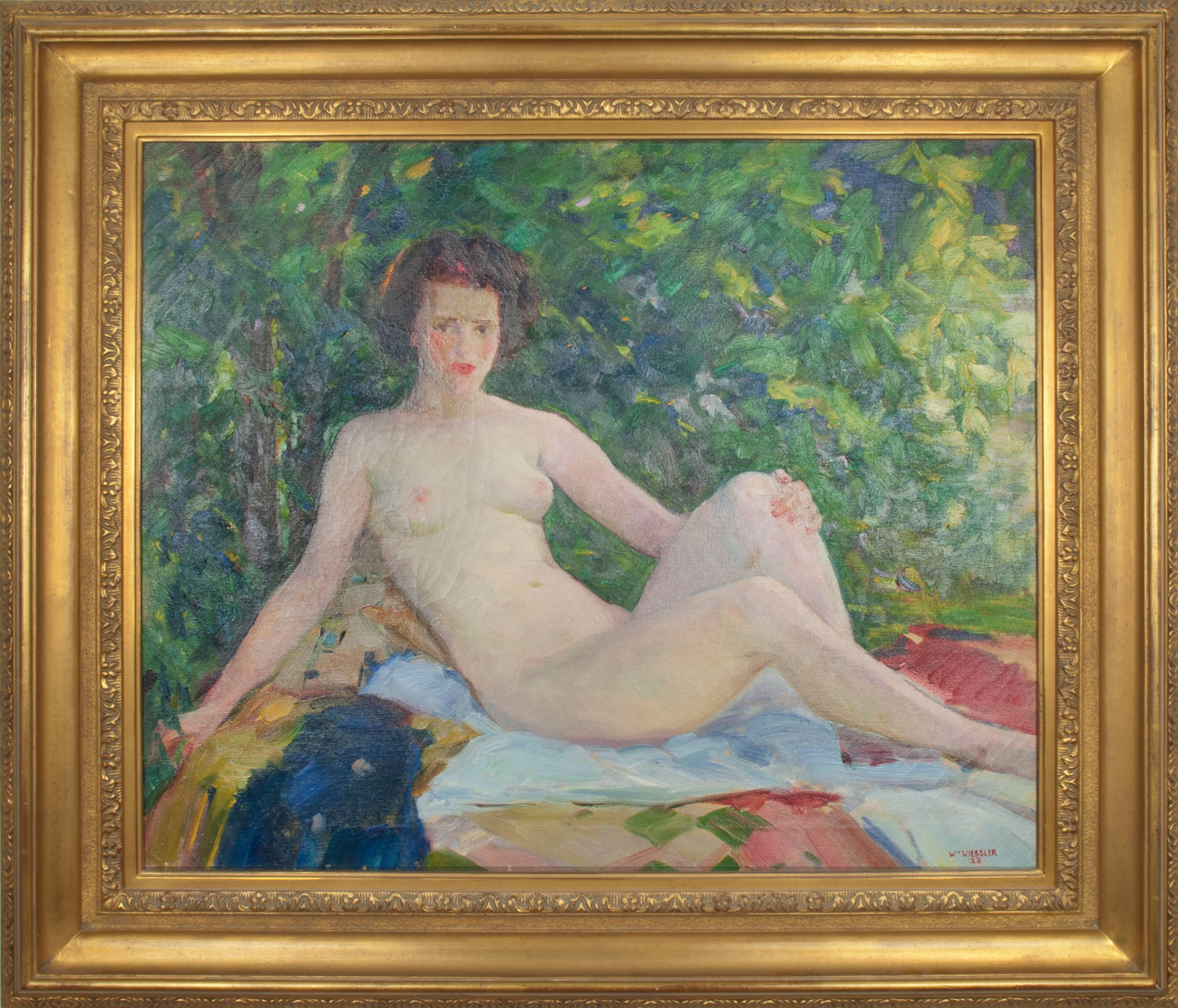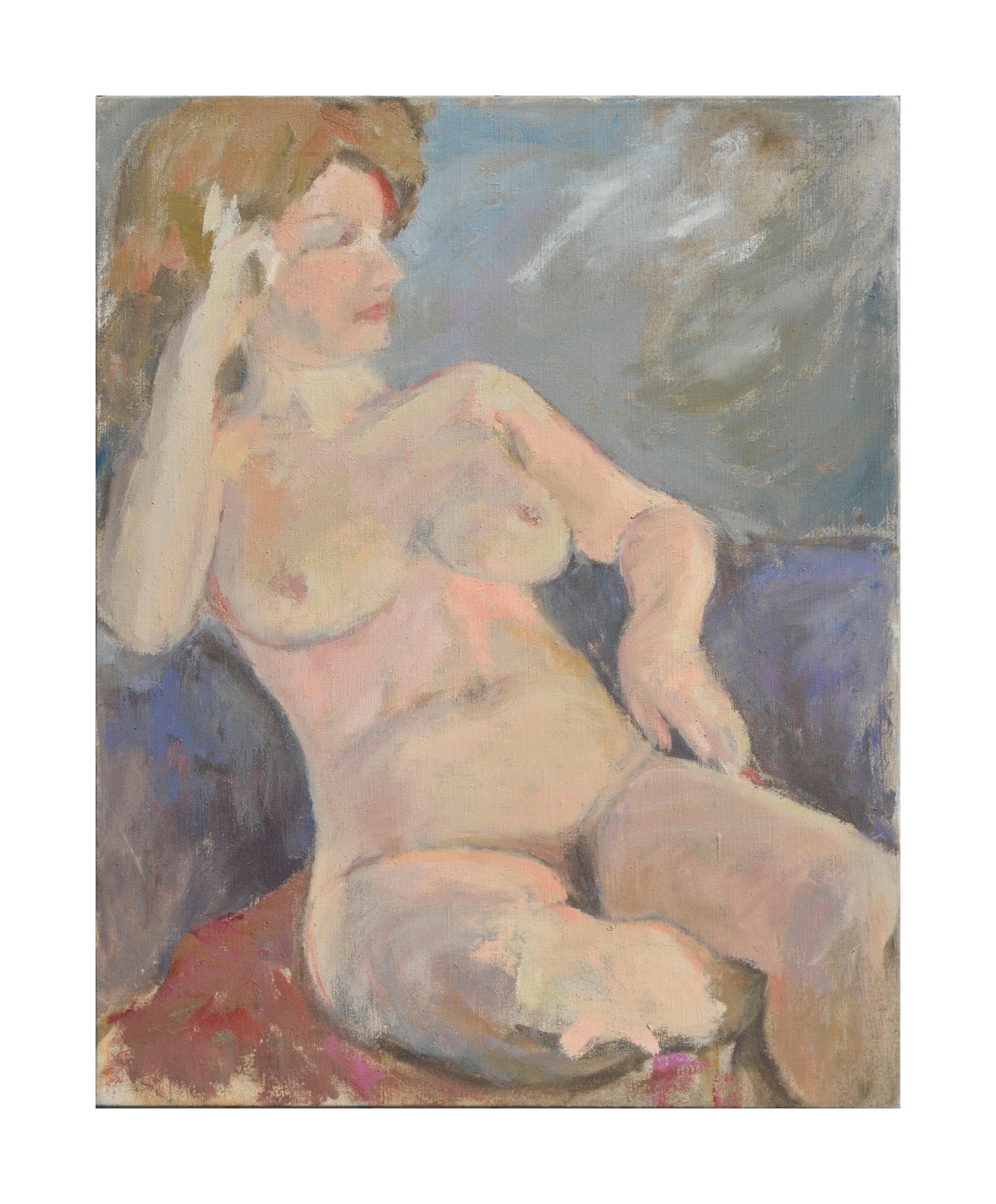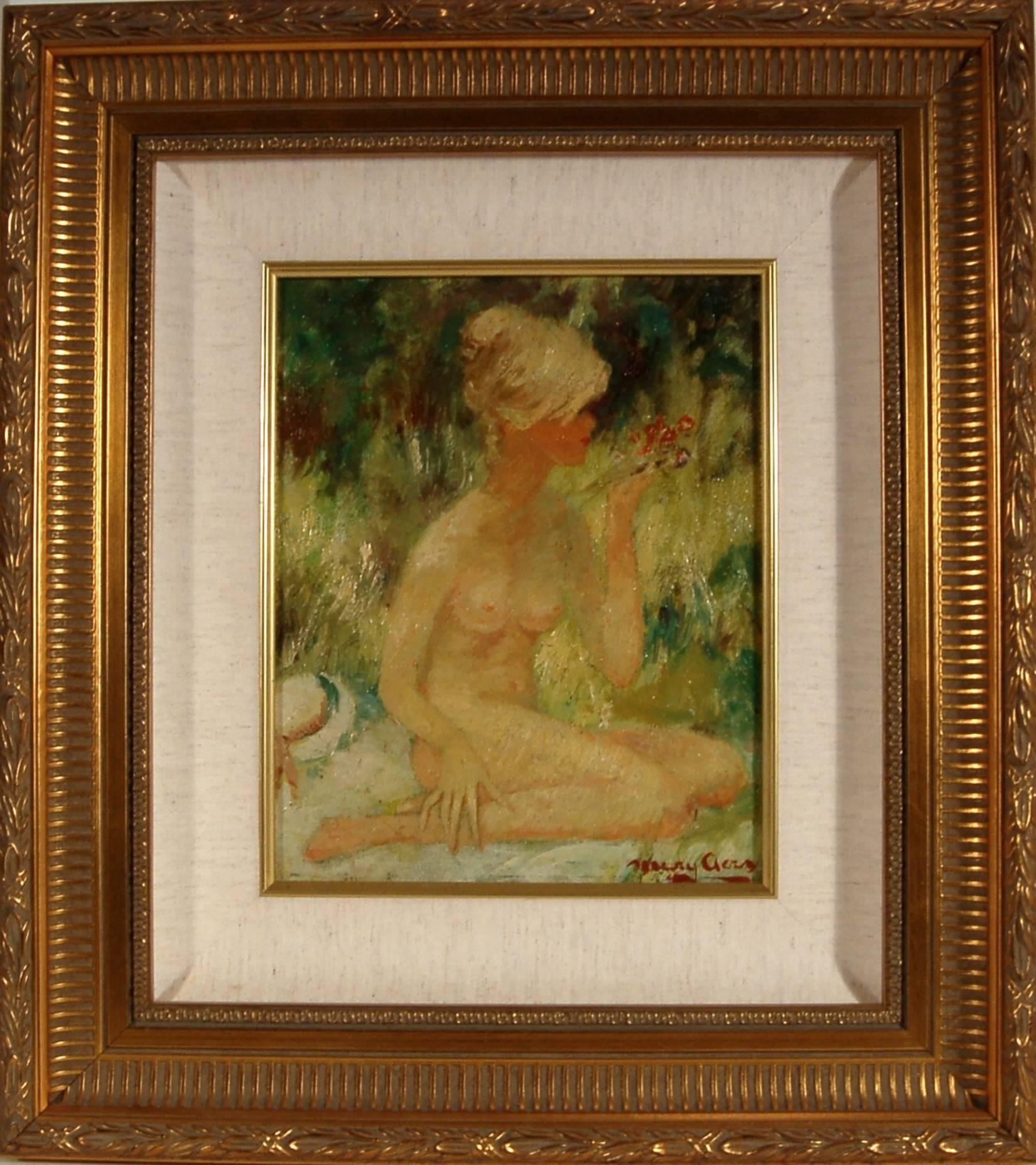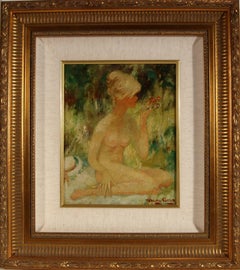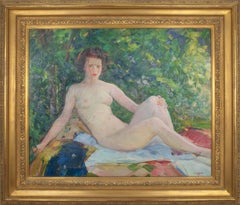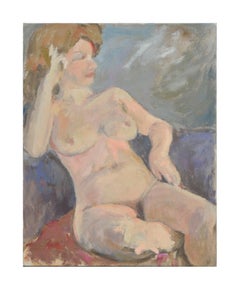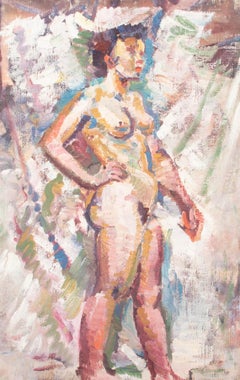Want more images or videos?
Request additional images or videos from the seller
1 of 10
Jan De RuthNudec.1980
c.1980
$2,300
£1,755.73
€2,018.33
CA$3,236.51
A$3,599.13
CHF 1,890.34
MX$44,003.03
NOK 23,555.49
SEK 22,206.47
DKK 15,063.24
About the Item
This artwork "Nude" is an oil painting on canvas by noted Czech/American artist Jan De Ruth, 1922-1991. It is signed at the lower right corner by the artist. The canvas size is 16 x 13 inches, framed size is 24 x 21 inches. Framed in the original wooden gold and black antique style frame, with fabric liner and gold bevel. It is in excellent condition.
About the artist:
Born Karlsbad, Czechoslovakia
Studied: Rotter Art School, Prague; Ruskin Art School, Oxford University, England; ASL New York; New School, NY; also with Frederic Taubes.
Exhibited: 38 National Juried Exhibitions, 14 Museum Solo Shows and 51 Gallery Solo Exhibitions.
Author: Portrait Painting, 1964; Painting the Nude, 1968.
De Ruth, a native of Czechoslovakia and an American citizen, spent the years of World War II being shunted through five different concentration camps, including the infamous Auschwitz. He made four escape attempts and finally made good on his fifth try.
De Ruth constantly sought materials with which to draw, but "The only things we had were the few pieces of cloth we wore," he recalls. By chance, he was transferred to Germany as part of a labor detail and managed to sneak a pencil away from the camp supervisor. "I became a perfect thief during those years," he says. De Ruth drew a mother and child on a scrap of paper he scrounged from the factory where he worked and filled it in with shadings of coffee in various strengths-his finger was his brush. He exchanged the sketch for a piece of bread from a camp guard, and in effect, sold his first painting.
In March of 1945, after being transferred to his native Czechoslovakia, he made his successful escape "knowing every step of the way." After the war, De Ruth became the commissar in a small Czech town and remained in the post for one year, just long enough to forge some documents that allowed him to flee to England. He took up residence in London and enrolled at the Ruskin Art School in Oxford University. He arrived in the USA in 1948.
There are times in the life of a painter when his dedication to his art is overshadowed by the immediate requirements of self-preservation. This was one of those times! From '48 to 1955 he supported himself by working at night, earning his way painting designs on neckties and bathroom cups; as a fashion designer, illustrator, vacuum cleaner salesman, theatre manager, and actor. In '55 Jan De Ruth made his professional debut as a full-time artist and two years later his first one-man show established him as a serious painter.
His work has been acclaimed for combining the technique of the Old Masters with a modern manner, and has been exhibited in more than 40 one-man shows in galleries and museums across the United States. He has been judged positively by juries in 28 national exhibitions, and his numerous awards include the Purchase Prize of the Butler Institute of American Art, and the Gold Medal of the National Arts Club.
De Ruth, author of the books Portrait Painting and Painting the Nude, has devoted his entire life to painting the female face and form. He enjoys special popularity as a portraitist, and has become one of the best known painters of the nude female in the world today. Often asked why he concentrates on this most demanding of all art subjects, he replies: . . . "Each painting of the nude becomes a new experience . . . It (the human figure) is nature's most perfect and most imperfect creation, communicating, even in silence and immobility, the physical and spiritual power-and frailty-of humanity."
Articulate, sophisticated, outspoken and well informed, De Ruth has also been a welcome guest on radio and television shows. But, it is painting that gives a purpose to Jan De Ruth's existence: "It is an unending challenge-there is no end, no final result-to be found in painting the human body. I have never seen two gestures that are alike, but so are the possibilities of expression. There will always be painters who will find one more way of saying: "See! This is what I feel about humans." . . . So until a greater challenge and a more profound symbol comes along, it is the human figure I wish to paint."
AWARDS
Butler Institute of American Art Purchase Prize
Oguniquit Art Center
Knickerbocker Artist 1964
Audubon Artist, Grumbacher Purchase Prize
National Arts Club of America Gold Medal
Windsor-Newton Award of the National Arts Club
ONE MAN MUSEUM EXHIBITIONS
B'nai B'rith Museum - Washington D.C.
Florida Gulf Coast Art Center - Clearwater, Fla.
Mint Museum of Art - Charlotte, N.C.
Neville Public Museum - Green bay, Wisconson
Lauren Rogers Museum - Laurel, Miss.
Theodore Wright Art Center - Beloit, Wis.
Bowling Green State College - Bowling Green Ohio
Catawba College - Salisbury, N.C.
East Central State College - Ada, Oklahoma
Fairleigh Dickinson University - New Jersey
Rochester Public Library - Rochester, N.Y.
NATIONAL EXHIBITIONS
Allied Artists of America
American Artists Professional League
Audubon Artists
Berkshire Art Association, Berkshre Museum
Boston Society of Independent Artists
Connecticut Academy
Knickerbocker Artists
National Academy of Design
National Arts Club
New York City Center
New York State Exposition
Ogunquit Art Center
Painters and Sculptors Society of New Jersey
Princeton Art Association
Springfield Museum Eastern States Exposition
- Creator:Jan De Ruth (1922 - 1991, American, Czech)
- Creation Year:c.1980
- Dimensions:Height: 24 in (60.96 cm)Width: 21 in (53.34 cm)Depth: 2 in (5.08 cm)
- Medium:
- Movement & Style:
- Period:
- Condition:
- Gallery Location:San Francisco, CA
- Reference Number:Seller: de/rut/nud/011stDibs: LU666311920242
About the Seller
5.0
Platinum Seller
Premium sellers with a 4.7+ rating and 24-hour response times
Established in 1999
1stDibs seller since 2017
829 sales on 1stDibs
Typical response time: 1 hour
- ShippingRetrieving quote...Shipping from: San Francisco, CA
- Return Policy
Authenticity Guarantee
In the unlikely event there’s an issue with an item’s authenticity, contact us within 1 year for a full refund. DetailsMoney-Back Guarantee
If your item is not as described, is damaged in transit, or does not arrive, contact us within 7 days for a full refund. Details24-Hour Cancellation
You have a 24-hour grace period in which to reconsider your purchase, with no questions asked.Vetted Professional Sellers
Our world-class sellers must adhere to strict standards for service and quality, maintaining the integrity of our listings.Price-Match Guarantee
If you find that a seller listed the same item for a lower price elsewhere, we’ll match it.Trusted Global Delivery
Our best-in-class carrier network provides specialized shipping options worldwide, including custom delivery.More From This Seller
View AllNude
By Rip Matteson
Located in San Francisco, CA
This artwork "Nude" c.1970 is an oil painting on panel by American artist Rip Matteson, 1920-2011. It is signed at the lower right corner by the artist. The panel size is 24 x 18 inc...
Category
Late 20th Century American Impressionist Nude Paintings
Materials
Oil
Nude
By Marguerite Aers
Located in San Francisco, CA
Artist: Marguerite Aers (Belgian, 1918-1995)
Title: Nude
Year: Circa 1970
Medium: Oil on hardboard
panel size: 11.75 x 9.5 inches
Signature: Signed lower right by the artist
Conditi...
Category
1970s Impressionist Nude Paintings
Materials
Oil
Nude
Located in San Francisco, CA
This artwork "Nude" 1947 is a watercolor on paper by noted California (German/American) artist Ernst Stolz, 1901-1989. It is signed and dated at the lower right corner by the artist....
Category
Mid-20th Century American Impressionist Nude Drawings and Watercolors
Materials
Watercolor
Nude
Located in San Francisco, CA
This artwork "Nude" c.1970 is an oil painting on canvas board by noted Mexican artist Luis Ricardo Amendolla Gasparo, 1928-2000. It is signed at the lower right corner by the artist....
Category
Late 20th Century Impressionist Nude Paintings
Materials
Oil
Sitting Nude
Located in San Francisco, CA
This artwork "Sitting Nude" 1949 is a watercolor on paper by noted California (German/American) artist Ernst Stolz, 1901-1989. It is signed and dated at t...
Category
Mid-20th Century American Impressionist Nude Drawings and Watercolors
Materials
Watercolor
Nude
By Betty Rees Heredia
Located in San Francisco, CA
This artwork "Nude" 1998 is a watercolor on paper by American artist Betty Rees Heredia A.K.A Betty Snyder Shapiro, 1919-2011. It is signed and date...
Category
Late 20th Century American Impressionist Nude Drawings and Watercolors
Materials
Watercolor
You May Also Like
Azaki, Nude Portrait Oil on Canvas by Jan De Ruth
By Jan De Ruth
Located in Long Island City, NY
Artist: Jan De Ruth, Czech (1922 - 1991)
Title: Azaki
Year: circa 1960
Medium: Oil on Canvas, signed l.r.
Size: 36 x 24 in. (91.44 x 60.96 cm)
Frame Size: 43 x 31 inches
Category
1960s American Impressionist Nude Paintings
Materials
Canvas, Oil
Nude
By William Wiessler
Located in Fairlawn, OH
Nude
Oil on canvas, 1923
Signed and dated lower left: Wm. Wiessler, '23 (see photo)
Condition: excellent
Canvas size: 24 1/4 x 29 1/4"
Frame size: 33 5/8 x 38 5/8"
Provenance:
Estate of the Artist
Radecki Galleries, South Bend
Thomas French Fine Art...
Category
1920s American Impressionist Nude Paintings
Materials
Oil
Mid Century Nude Study
Located in Soquel, CA
Beautiful oil painting of nude study titled "The Red Table Cloth" by Bay Area, California artist Shirley Loyst (American, b-1928), circa 1960. Exhibition...
Category
1960s American Impressionist Nude Paintings
Materials
Canvas, Oil
Impressionist 20th Century Oil - Posing Nude Figure
Located in Corsham, GB
Unsigned. On unstretched canvas.
Category
21st Century and Contemporary Portrait Paintings
Materials
Oil
$232 Sale Price
20% Off
Mid-Century Abstracted Nude
Located in Soquel, CA
Expressive mid-century abstracted figurative of a reclining woman by an unknown artist (American, 20th Century). Impasto gives added depth and interest. Unsigned. Unframed. Image siz...
Category
1970s American Impressionist Nude Paintings
Materials
Canvas, Oil
$1,160 Sale Price
20% Off
The Early Hours, Impressionist Nude Oil Painting by Jan De Ruth
By Jan De Ruth
Located in Long Island City, NY
Artist: Jan De Ruth, Czech (1922 - 1991)
Title: The Early Hours
Year: circa 1964
Medium: Oil on Canvas
Size: 44 in. x 21 in. (111.76 cm x 53.34 cm)
Frame Size: 50 x 27 inches
Category
1960s American Realist Nude Paintings
Materials
Oil
More Ways To Browse
Black Female Nudes
Four Nudes
Nude Self Portrait
Nude Mother
Jans Antiques
Vintage Bathroom Painting
German Female Nudes
Actor Nude
Portrait Of Ruth
Nude Old Man
Americas Cup Oil Painting
Lauren C Paintings
Vintage Gulf Oil
Jan Rogers
Antique Oil Portrait Child
Coffee Cup Oil Painting
Vintage Radio Made In Germany
Vintage Green Coffee Cups
